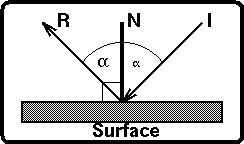 6.3. Reflection.
6.3. Reflection.  6.3. Reflection.
6.3. Reflection. There are two basic types of reflection : specular (or
regular) and diffuse (or spread).
a) Specular Reflection : reflection from a planar surface.
Here I represents the incident ray, N represents the direction of
the surface normal vector (i.e. the vector leaving the surface at
right angles), alpha represents the angle of incidence, and R the
reflected ray. Note that the angle of incidence equals the angle
of reflection
b) Diffuse Reflection : Rough (or matt) surfaces do not produce regular reflection. Rather they spread the incident rays in all directions, with some of the rays originating from each light source reaching the viewer unless the object is totally shadowed from that light source. Using Lambert's cosine law, as described in [WHIT 80], the intensity of diffusely reflected light is proportional to the cosine of the angle between the surface normal and the direction of the light source.

Fig. 6.1 : Reflecting Rays.
Most surfaces exhibit a mixture of these two types of reflection. Reflected light from a mirror will be mainly specular, whereas reflected light from matt paint will be mainly diffuse, with a polished floor exhibiting a reasonably even mix of specular and diffuse reflection. Thus the greater the coefficient of specular reflection, the glossier the surface will appear.












